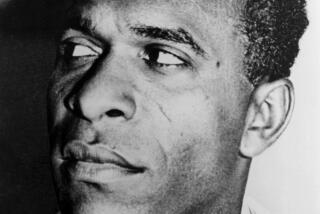‘The Lazarus Project: A Novel’ by Aleksandar Hemon
The Lazarus Project
A Novel
Aleksandar Hemon
Riverhead Books: 294 pp., $24.95
First, a small historical marker:
On March 2, 1908, Lazarus Averbuch, a 19-year-old Jewish émigré from Eastern Europe, paid a visit -- for reasons unknown -- to the home of George Shippy, Chicago’s chief of police. Perhaps he was looking for work and wanted a letter of good character, a custom back home. But Shippy claimed to have seen hatred in Lazarus’ eyes and a knife pulled from his pocket. Not knowing Lazarus and caught up in the xenophobic, anti-radical hysteria of the times, Shippy took him for a murderous anarchist. In the skirmish that followed, Lazarus took seven bullets and died on the way to the hospital. His death became a flash point for left and right, and the truth around it remains smoked in mystery.
A century later, Aleksandar Hemon, a novelist (“Nowhere Man”) and story writer (“The Question of Bruno”) born in Sarajevo, now living in Chicago, became interested in Lazarus’ story and, accompanied by his friend photographer Velibor Bozovic (whose photos grace the book), set about tracing Lazarus’ short, unhappy path from Kishinev (today Chisinau), the capital of Moldova. There, as a child, Lazarus survived the pogrom of 1903 and escaped with his family to Chernivtsi, then on to Chicago for his appointment with fate.
The result of the journey is “The Lazarus Project,” a novel about a man named Brik, a writer from Bosnia now living in Chicago, who takes his friend, Rora, a photographer, on a trip to retrace Lazarus’ path. Brik envies Rora for having been in Bosnia to fight in the war of the early 1990s; Rora envies Brik for having missed it. Their homeward trek holds different meanings for each.
Hemon places his narrative on two tracks: Lazarus’ story weaves in and out of Brik’s -- two very different immigrant experiences. As the book begins, Brik’s worst complaint about America is the inferiority of its coffee. He seems to be doing all right: He writes a column for the Chicago Reader and loves Mary, his American wife, a neurosurgeon with little patience for the bleakness in her husband’s Eastern European soul: “I seldom talked to Mary (or anyone else, for that matter) about such things, about the metaphysics, the existential loneliness, the ways of being. She was a lifesaver; she worked on life, the way people work on their cars -- she was a life mechanic.”
The road trip -- thick with bonding, booze and opulent stories; a sort of “Sideways” with worse wine -- winds through Ukraine and into Moldova. Brik captures the local color in the collapsed Soviet Union -- rich gangsters and hooker-filled hotels, a local museum with a display of indigenous cockroaches. Brik’s acidic commentary is often hilarious. In a hotel room in Lviv, “The singer on TV was a matronly woman in a curtain-like, glittery dress, awkwardly swinging her thick hips between chairs and tables, while a toreador-mustached man, all tension and sinews . . . twisted and pressed luridly against her sides. It was clear that the couple was Ukrainian, the way it is clear that it is morning in the morning.”
When the narrative takes up Lazarus, the prose is set in darker ink. In Chernivtsi, Brik imagines: “Here Lazarus lost his first money gambling; here he was flagellated in his dreams by the Kishinev pogromchiks; here he was deflowered; here he first felt adrift in a foreign land; here he learned that humanity is wicked and endless.” Eventually, the search for Lazarus becomes personal for Brik. In Chisinau, “I felt as though I had achieved the freedom of being comfortable with the constant vanishing of the world. I had finally become the Indian on a horse with a branch tied to its tail.” In Sarajevo, which might well be the real point of the trip, some very bad events cause things to both fall apart and come together for Brik.
Though his story and Lazarus’ provide dramatic contrasts, there’s an off-kilter sway to the narrative as the tone flips between dark humor and the brand of sorrow you can’t joke your way around. Hemon is immensely talented -- a natural storyteller and a poet, a maker of amazing, gorgeous sentences in what is his second language. But in this book, he sets up a Chinese box structure that has its own constraints, which might not play particularly well to his discursive style.
The parallel protagonists of this book are separated by more than just a century. Lazarus did not have the luxury of angst. He was a Jew struggling simply to stay alive in an anti-Semitic, anti-immigrant culture. After his death, the novel tells how the Chicago Tribune ran a front page photo of Lazarus in profile under the heading “The Anarchist Type,” with numbers delineating his telling features: “1. low forehead 2. large mouth 3. receding chin 4. prominent cheekbones 5. large simian ears.”
How could he have thrived in a place where this could happen? In his Chicago, Brik’s sorrow is more a vapor that he inhabits, an atmospheric state he brings with him. For Lazarus, the oppositional forces were life and death, divided by a sharp, dark, stationary line. For Brik, the psychic players are happiness and unhappiness, which share a border that shifts, much like those on the countries of his Balkan peninsula. *
Carol Anshaw is the author of the novels “Aquamarine,” “Seven Moves” and “Lucky in the Corner.”
More to Read
Sign up for our L.A. Times Plants newsletter
At the start of each month, get a roundup of upcoming plant-related activities and events in Southern California, along with links to tips and articles you may have missed.
You may occasionally receive promotional content from the Los Angeles Times.






